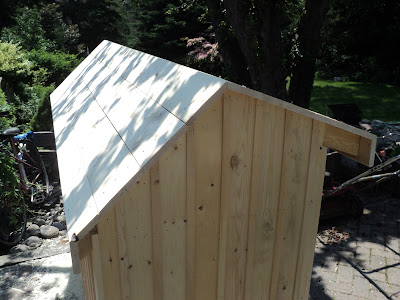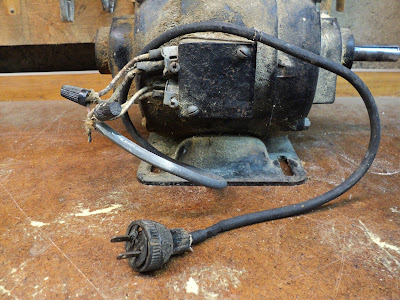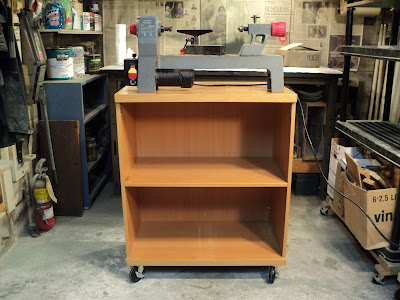Our home has a fireplace of sorts. It's an old acorn style, like so.
As I understand it, acorn fireplaces are long out of fashion. They're inefficient. Still and all, it is a fireplace, and a fire in it on a winter evening is a very pleasant thing indeed. And in a pinch like an extended power outage the thing could be salvation, in spite of its inefficiency, provided that there's an adequate supply of firewood on hand. So, I thought it wise to finally get around to constructing a woodshed.
I looked around for suitable woodshed plans on the internet, and found an article that pictured a beautiful design. I really like the looks of the woodshed pictured in that article.
That's a beauty, but the article is a bit of a fraud. The plan given in the article is for a shed that's nothing like the pictured one. Emailing the article's publisher about it got me nowhere, so I set about working out a plan myself. That's been an interesting and challenging exercise that's left me in awe of those who can design and build wood structures.
I've managed to draw up the beginnings of a plan for a shed that will resemble the item pictured above. I have enough of a plan drawn up for me to get started on construction, but I don't know enough about construction carpentry to draw up a plan with every last detail in it. So, beyond the initial floor and wall framing, I'll have to make it up as I go along. We'll see how this works out.
My shed will have a 2' by 6' footprint, and stand about 4 1/2' tall at the peak of its roof. Here's a view of the floor foundation completed.
The two skids are 4" x 4" MCA pressure-treated wood. They're to be the only pressure-treated parts of the shed -- I think that pressure-treated wood is way overused.
The framing is 2" x 4" SPF (spruce/pine/fir), held together with No. 8 x 3" deck screws. To attach the framing to the skids, I splurged and got Kreg's HD pocket screw jig. Here's a view of that item at work.
I've long been intrigued by Kreg's pocket screw gear, and this was my excuse to finally acquire some and try it out. I'm impressed. The gear works as advertised. With No. 14 x 2 1/2" screws installed, that woodshed floor foundation is a very sturdy construction.
Flooring
The flooring is 1" x 4" SPF planks, spaced 1/2" apart so there can be some air circulation up through the shed from below. The planks are nailed down with 1 1/2" common spiral hot galvanized nails.
Rear Wall Framing
That framing is all 2" x 3" SPF, held together with No. 8 x 3" deck screws. I expect to be using that size and style of screw extensively throughout the construction of the shed.
Side Walls Framed
Front Framing Less Corner Braces
That centre post is the two off-cuts from the skids. I joined them end-to-end with biscuits and Gorilla Glue to make a long-enough piece for that post. I also used that method to salvage some 2" x 3" off-cuts for studs, as in the following photo.
Doing that saves considerable waste.
Rafters And Front Corner Bracing Installed
Cross-Bracing Installed
I added that cross-bracing because I've decided to go with vertically arrayed board-and-batten siding.
Siding Begun
Here's the first vertical board in place.
That board clamped along the bottom gives me a registration edge for the bottom ends of the siding boards. Then it's easy to mark a board's upper end to agree with the roof line, and cut it with a hand saw just like a real carpenter would. It should look pretty decent when it's all done. I used 1 1/2" hot galvanized spiral finishing nails to attach the vertical board. I wouldn't mind having an air nailer for this, but that's something I've yet to acquire.
Siding Progress
Here's one end of the shed fully sided, with a few battens installed.
The battens are about 7/32" x 3/4" that I ripped from 1" nominal stock. I've attached the battens with 5/8" brads from an Arrow electric stapler. The stapler is just barely up to the task -- I've had to hammer most of the brads to fully seat them.
I carried the siding around the front corner by 1 1/4" for the sake of a more finished appearance.
That's as far as I want to go for a corner treatment.
One Side Fully Battened
Fully Sided
Front Fascia Board
Here's the clamp-up I rigged to allow me to install the front fascia board without assistance.
And here we are with the front fascia board fastened in place with No. 8 x 2 1/2" deck screws.
Next up is the rear fascia board, then the roofing planks.
- - -
Roof Planked And Both Fascia Boards Installed
Now I have to finish off the gable ends with bargeboards. That will be a bit of a challenge. I have quite a few 1" x 6" off-cuts left to me from the backside and roofing planks. I may make up some bargeboard material from those by biscuit-joining off-cuts together to make long enough boards.
Bargeboards Installed -- SATURDAY, JULY 8, 2017
The most mentally taxing work I've ever done in my life. There were three different angles that had to be discovered, and then expressed with the table saw's mitre gauge. One is constantly doing the mental gyrations necessary to keep it straight in one's head the position and orientation of each angled saw cut. Mistakes could easily be made, and would be costly in ruined material.
Anyway, that's over and done with, and I was able to salvage some off-cuts into the deal.
Drip Edges Installed
The drip edge material is Amerimax No. 3715419 from the Home Depot. I just installed it according to what seemed right to me. Information in this 'information age' can be hard to come by and sketchy. Anyway, that should do what it's supposed to -- keep water from wicking back between the shingles and the substrate.
Roof Shingled -- TUESDAY, JULY 11, 2017
In the above photo, the roof is just awaiting its ridge cap. The shingles are GAF MARQUIS WeatherMax 3-tab, charcoal colour from the Home Depot. Only one bundle was needed to do the entire roof.
Done And In Position -- WEDNESDAY, JULY 12, 2017
I gave the outside and the floor one application of Thompson's Water Seal. Now the shed can peacefully stand where it is and weather, and test out my assertion that pressure treated wood is way overused.
# # #
# # #

















































